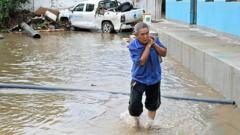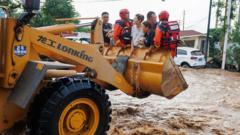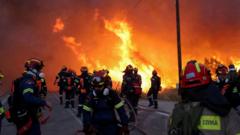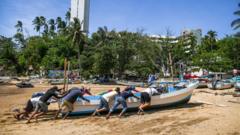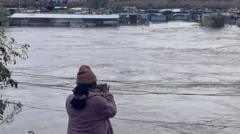In the wake of Hurricane Erick's fury, southern Mexico is mobilizing resources for a substantial clean-up effort, particularly in the tourist hotspot of Puerto Escondido.
Mexico Undertakes Massive Clean-Up Operation Following Hurricane Erick

Mexico Undertakes Massive Clean-Up Operation Following Hurricane Erick
Efforts intensify in southern Mexico to restore normalcy after Hurricane Erick causes significant damage.
Hurricane Erick, which made landfall on Mexico's Pacific coast as a formidable Category 3 storm, hit the town of Puerto Escondido in Oaxaca hard on Thursday, leaving it devoid of electricity and communication services due to extensive damage to infrastructure, including two hospitals and major roads now inundated with water. Thankfully, there have been no reports of casualties or injuries.
After making landfall, the storm was downgraded to Category 1; however, forecasts from the US National Hurricane Center (NHC) indicated that severe flooding and high winds would continue to impact the area as Erick moved northward. Officials warned of potentially "life-threatening" storm surges and waves reaching heights of 10 meters (33 feet) along the coast.
In light of the destruction, hundreds of soldiers were dispatched to assist in clean-up efforts in Puerto Escondido, where several buildings incurred damage and waterways overflowed. Local shopkeeper Luis Alberto Gil described the floodwaters as unprecedented, stating, "The water had never hit with this magnitude."
State-owned utility company CFE reported that over 120,000 customers in Oaxaca were left without power, with restoration efforts reaching a quarter of the affected population by late morning. Wind gusts in the area peaked at 125 mph (205 km/h) before tapering down to 85 mph.
Further along the Pacific coast, Acapulco remained largely unoccupied as residents took precautionary measures in response to storm warnings—shops boarded up, and tourist boats secured on land. In anticipation of potential hazards, many residents stocked up on essential items, including food, water, and fuel.
As cleanup efforts continue, alerts for hazardous flooding and mudslides persist in Oaxaca and neighboring Guerrero states. Similarly, warnings of dangerous storm surges remain in effect. Despite the risks, the NHC noted that Hurricane Erick was expected to weaken rapidly and likely dissipate by the end of Thursday.
President Claudia Sheinbaum urged individuals to remain indoors and advised those in vulnerable regions or near rivers to utilize one of the approximately 2,000 emergency shelters prepared across Chiapas, Guerrero, and Oaxaca ahead of the storm's arrival. The spirit of recovery is especially poignant in the region, where communities are still grappling with the aftermath of Hurricane Otis, which devastated Acapulco in 2023 and resulted in over 50 fatalities.
As residents begin to assess the damage and participants seek to restore normalcy, the focus remains on safety precautions and support for those affected. Residents in impacted areas are encouraged to share their experiences with news outlets to help amplify the community's voice during this crisis.
After making landfall, the storm was downgraded to Category 1; however, forecasts from the US National Hurricane Center (NHC) indicated that severe flooding and high winds would continue to impact the area as Erick moved northward. Officials warned of potentially "life-threatening" storm surges and waves reaching heights of 10 meters (33 feet) along the coast.
In light of the destruction, hundreds of soldiers were dispatched to assist in clean-up efforts in Puerto Escondido, where several buildings incurred damage and waterways overflowed. Local shopkeeper Luis Alberto Gil described the floodwaters as unprecedented, stating, "The water had never hit with this magnitude."
State-owned utility company CFE reported that over 120,000 customers in Oaxaca were left without power, with restoration efforts reaching a quarter of the affected population by late morning. Wind gusts in the area peaked at 125 mph (205 km/h) before tapering down to 85 mph.
Further along the Pacific coast, Acapulco remained largely unoccupied as residents took precautionary measures in response to storm warnings—shops boarded up, and tourist boats secured on land. In anticipation of potential hazards, many residents stocked up on essential items, including food, water, and fuel.
As cleanup efforts continue, alerts for hazardous flooding and mudslides persist in Oaxaca and neighboring Guerrero states. Similarly, warnings of dangerous storm surges remain in effect. Despite the risks, the NHC noted that Hurricane Erick was expected to weaken rapidly and likely dissipate by the end of Thursday.
President Claudia Sheinbaum urged individuals to remain indoors and advised those in vulnerable regions or near rivers to utilize one of the approximately 2,000 emergency shelters prepared across Chiapas, Guerrero, and Oaxaca ahead of the storm's arrival. The spirit of recovery is especially poignant in the region, where communities are still grappling with the aftermath of Hurricane Otis, which devastated Acapulco in 2023 and resulted in over 50 fatalities.
As residents begin to assess the damage and participants seek to restore normalcy, the focus remains on safety precautions and support for those affected. Residents in impacted areas are encouraged to share their experiences with news outlets to help amplify the community's voice during this crisis.

